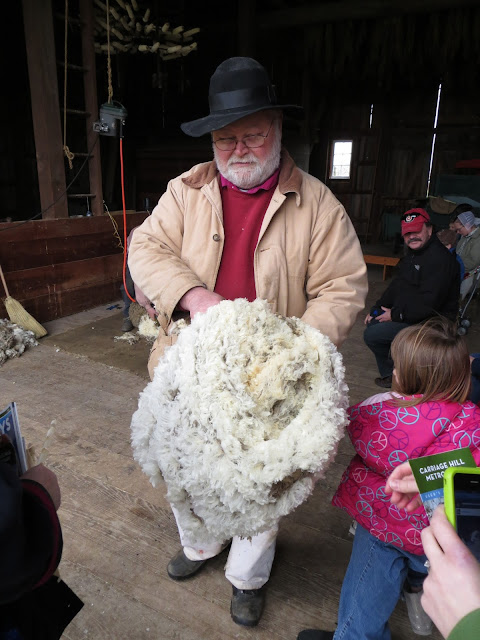My husband and I took a little trip to the Carriage Hill Metropark here in Dayton this afternoon for the "From Sheep to Shawls" event. Carriage Hill Metropark is a farm that dates back to the 1880's. They have merino sheep, horses, chickens, mules, donkeys, pigs, and a goat (maybe more than 1 goat, I only saw the one today). It reminds me of Spring Mill in Indiana with the little shops set up to demonstrate how things were done back then...such as blacksmithing and woodworking.
Today, the farm was all about the merino sheep. In the large, red barn, there was a man shearing sheep. My husband and I had never seen sheep being sheared before, so it was very interesting. The sheep was so relaxed, as though she was in a trance. Once in awhile she would get a bit irritated with the shearer, but she was really well behaved for the most part. We spoke with one of the farmers there, and he said that merino sheep are very docile when being sheared. We asked what they do with the wool, and they let some of the volunteers spin it for demonstrations, and the rest they sell to a place in Columbus, OH. He gave me a little bit of raw merino while he spoke with us.
The man shearing was using electric shears. Though, in the 1880's, they would have used clippers. It took so long using the electric shear, that I can't imagine how long it would have taken for just regular clippers! And I would think that would have been harder on the sheep too. Merino sheep have such wrinkly skin, that it's very easy to nick the skin as they are being sheared, but, we were told that they stop bleeding very quickly, so if they are nicked, they heal easily.
 |
| Beautiful, raw merino wool. |
 |
| This was sheared off of one sheep. GORGEOUS! |
 |
| In line for shearing. |
This barn cat was sitting off to the side while the sheep were getting sheared. I bet it was glad it didn't have to be sheared. :)
Inside the barn, we saw the most adorable lambs! AWE!!!
This black lamb is the very first black lamb to appear on the farm. So special.
Don't want to leave out pics of the other farm animals.
Inside the house, we saw this lovely stove in the kitchen. Imagine cooking food on and in this back then.
We enjoyed watching a man use a lathe to make two, wooden tops for the kids standing by watching. It didn't take him 10 minutes to make them, and those little kids went home with unique, handmade wooden tops. So cool! I wouldn't mind having one of these to play with.
Inside the Visitor Center, there was a little museum outlining the history of the family who owned the farm. This walking spinning wheel came to Ohio with Catharine Harshbarger Arnold in 1830.
It was a lovely way to spend the afternoon.
We look forward to going back again to do the hiking trails and to see the sheep again.






















Thank you so much for sharing this. I had hoped to be able to go when I saw your first post, but it was not to be. Lovely photos and great information.
ReplyDeleteThanks, again.
Thanks for your comment, Diane. Sorry you were not able to make it there, but glad you could enjoy it vicariously through my post. :)
DeleteRats! This is now two years in a row I've missed this event!! Thanks for all the pictures though; we'll have to take a trip out there to visit.
ReplyDeleteI think the Merino's skin is so odd. I've been reading a LOT about sheep lately since we're getting our flock in May and I thought skin folds were a bad thing. Did they cover the nicks? Probably too cold for flies right now.
Sorry you missed the event. Do you have "The Fleece & Fiber Sourcebook?" http://astore.amazon.com/thepurledewe-20/detail/1603427112 It has so much great info on sheep. I'm glad you guys are getting some in May! That's exciting! They didn't cover the nicks on the sheep because we were told merino stop bleeding almost instantly. They also had them in the barn on that cold day, so I guess they weren't worried about flies. I've read how some farmers do very cruel things to merino sheep to keep flies from laying eggs in their skin folds. It's terrible to read about. The farm had a sign in the visitor's center about merino, and that the farm is actually trying to breed for more skin folds! I thought that was interesting.
Delete